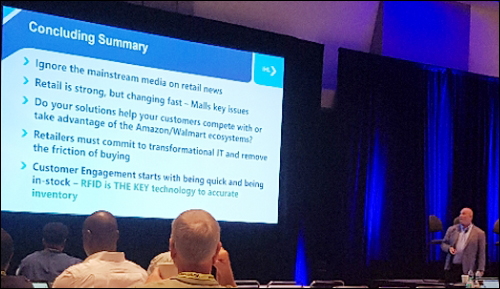Jun 27, 2019During the first presentation of day two of the RFID Journal LIVE! Retail conference and exhibition, held at RetailX in Chicago, Illinois, Greg Buzek, the president of the IHL Group, said, "A number of innovations that are rapidly advancing in retail today are effectively dependent on proper and accurate control of product stocks." For him, BOPIS (buy online, pick up in store) projects, for example, rely entirely on technologies that offer this level of accuracy.
Buzek's opinion is shared by retail RFID technology specialist Dr. Bill Hardgrave, of Auburn University's RFID Lab. Hardgrave told attendees that without inventory accuracy, it is impossible to ensure the expansion of a retail business for which customers demand to have the quality of service they want.
"The ability to increase sales while meeting the quality standards required today requires effective RFID stock control, the best technology to achieve this critical level of accuracy," Hardgrave stated. Asked how barcodes could be used to ensure inventory efficiency, Hardgrave explained that the maximum possible readability for barcode counts is far less than that of RFID, which is at nearly 100 percent.
Hardgrave was emphatic in saying that hit rates in product counts are directly related to the type of commodity being inventoried. "It cannot be guaranteed that different classification products, such as footwear and clothing, for example, have the same readability index," he noted, "since the characteristics of products, materials, packaging and even accessories can impact this." He added, however, that despite this fact, RFID still offers an accuracy rate of close to 100 percent.
Considering the current scenario in which a lot of sales are made online, Buzek reported that consumers these days go to physical stores for two main reasons: because they need to find a particular product by a given date, or because they want to touch the item with their hands or gain information from an employee in person. "Physical stores are losing customers annually due to inventory-management problems," he said, adding that this scenario can be reversed.
According to Buzek, a winning retailer needs to utilize the concept of unified commerce, which means keeping an accurate view of the products it has in stock without separating the channels for which they are intended. That is, retail businesses must maintain control over a unified stock in order to facilitate ominichannel sales.
Hardgrave focused his presentation on demonstrating that accurate product counts and inventory visibility play crucial roles in the future of retail. He said that this can especially ensure the success of omnichannel initiatives and other tactical operations, such as BOPIS.
Buzek presented a study showing an unprecedented fact in the history of retailing. "For the first time, we are seeing retailers at a time when IT spending is higher than all other expenses added," he stated. "What's more, companies are investing without expecting an immediate return on investment, looking for a unified account of their inventory."
Another conclusion of the study presented by Buzek is that the impact of RFID for those who invest in technology is an average sale increase of almost 300 percent, "especially thanks to gaining accurate inventory information." RFID is not the core technology for loss control, he noted, though it can provide an important secondary layer.
Buzek also reported that artificial intelligence and machine learning will greatly impact inventory counting during the coming years, and that sales forecasting can only reach its full potential once companies have deployed RFID. "AI and ML require clean and accurate data," he maintained.



